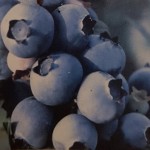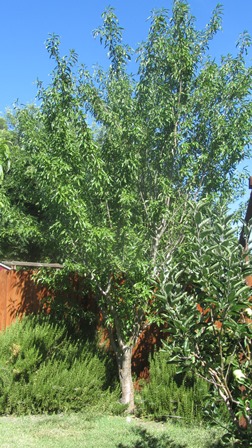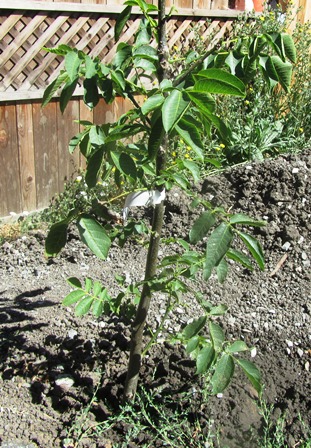Growing Blueberries in the Bay Area
My Henny Penny Farmette is not far removed from ranch land populated by cows and dotted with towering oaks and pines. In the blistering heat of summer, the surrounding hills and canyons support little more than star thistle and wild grass that dries to become the perfect tinder for wildfires. Until recently, I doubted I could ever successfully grow blueberries that need the moist, acidic soils, more common to the Northeast and deep South.
However, after reading the University of California paper on growing blueberries here in the West, especially in the nearby Central Valley and also the Santa Clara Valley, I decided to try a couple of plants. See, http://ucce.ucdavis.edu/files/filelibrary/5842/25993.pdf.
I chose to grow Sharpblue (a southern highbush type of blueberry). These plants have beautiful blue-green foliage and a compact growing habit. When they reach their full height, they will stand 6-8 feet high and 4-6 feet wide. The plants are self-fertile.
This plant produces both flowers and fruit throughout most of the year; the fruit can be picked from midsummer through the fall. To my surprise, the plant bore fruit this year.
Northern lowbush blueberries grow well in northern U.S. states and in Canada where moist soil and long hours of winter chilling fulfill the plant’s growing requirements.
For best results in the Bay Area, choose highbush blueberries such as the following: Sharpblue, Sunshine Blue, Bluecrop, Blueray, Ozark Blue, Georgia Gem, Misty, Reveille, Cape Fear, and O’Neal. Plant them in acid soil that drains well and is porous.
They may also be planted in containers on patios but require plenty of water and six hours of sun. In the hottest areas, provide part sun/shade.
Blueberries taste great in pancakes, muffins, strudels, and coffee cakes. They’re delicious in jams or stirred into yogurt (my favorite). Just a single cup of this low-cal fruit is packed with Vitamin C, fiber, and antioxidants. Freeze extra berries to enjoy later.
Try making this taste-pleasing recipe posted online at WebMD.com for Blueberry Nectarine Granola Crisp. See, http://www.webmd.com/food-recipes/features/blueberries-nutritious-things-come-in-small-packages_
_______________________________________________________________
If you enjoy reading about farmette topics, gardening, and keeping chickens and honeybees, check out my series of cozy mysteries from Kensington Publishing in New York.
Click on this link: http://tinyurl.com/ya5vhhpm
Click on this link to see The MURDER OF A QUEEN BEE: Click on this link: http://tinyurl.com/yd7pz7af
Northern California Nut Trees in a Nutshell
Take a trip into Northern California’s great Central Valley and you’ll notice how the landscape becomes dotted with nut tree farms along with vegetable fields, fruit tree orchards, and dairy farms. While Texas dominates the pecan tree market, California’s big three nut crops are almonds, walnuts, and pistachios. With nut prices on the increase, backyard gardeners might consider planting a tree or two if they have the space.
Some nut trees, such as almonds, require pollination assistance–a couple of different cultivars and honeybees will do the trick. For this reason, commercial almond growers pay beekeepers to bring their hives in to pollinate California’s early almond crop each year. Growing almonds is big business in California (it’s the third leading agricultural product in the state); the decline in honeybee populations is bound to affect this profitable crop.
The Central Valley has the perfect climate and growing conditions for almonds. It’s estimated that there are roughly 5,500 almond growers in the state. Many are commercial growers who capitalize on the rich, well-drained soil, and the hot summers and cool winters of Northern California. But California’s continuing drought is causing concern to almond growers since almonds require a lot of water. Backyard gardeners, too, must consider the water requirement of almonds before planting trees.
A newly formed almond on the tree looks like an unripe fuzzy peach because almonds are related to the peaches. Mature almond trees reach 20 to 30 feet tall. Some popular cultivars in zones 5 through 8 are Hall’s Hardy, Nonpareil, Peerless, and Mission. My neighbors have gorgeous, healthy almonds growing on their farmette.
The California Black Walnut and Persian Walnut (with cultivars of Franquette, Chandler, and Hartley) are valued for their stateliness, shade, bountiful crops, and longevity. Walnuts contain healthy nutrients. Cultivars of the English walnut are fast-growing and the nuts are thin-skinned and bountiful.
If a walnut is planted at the birth of an individual, and he lives 75 years, that walnut tree might could still be growing when the person breathes his last breath. The black walnut can reach 100 feet in height. The nuts have an thick outer hull that can blacken sidewalks and driveways with their stain; also, the tree also can be toxic to other plants.
In comparison to walnuts, filberts/hazelnuts are considered small trees (achieving heights of only 10 to 40 feet), they are often the nut tree of choice for backyard landscapes. DuChilly and Daviana are excellent pollinizers with Barcelona. Other cultivars are Bixby, Royal, and Hall’s Giant.
Pecan trees grow much larger than filberts, often towering 70 to 150 feet. Some cultivars include Major, Peruque, Stuart, and Colby. The cultivars of Wichita, Western Schley, and Cherokee are excellent pollinators for each other. Of all the nuts valued for their antioxidants, pecans rank the highest.
There is a pistachio tree growing a mile or so from my farmette. While pistachios love the Mediterranean climate of the Central Valley, in some places the trees perform better than in others. The nuts are highly valued by consumers. Growers have taken notice. Pioneer Gold, a varietal that’s been around since 1976, remains a popular choice. The trees are wind pollinated and require a male and female tree for a crop set.
If you have room in a backyard garden or on a farmette or field, consider planting one or more nut trees. You’ll be rewarded with shade and heart-healthy, nutritional snacks for years to come.
 Facebook
Facebook Goodreads
Goodreads LinkedIn
LinkedIn Meera Lester
Meera Lester Twitter
Twitter










